#kriegsmesser
Text
The sword of the day is the Kriegsmesser.
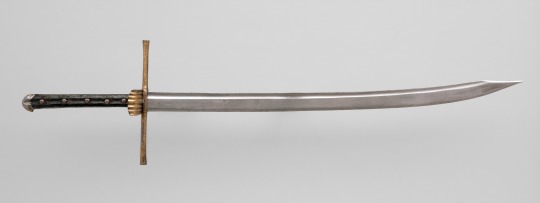
The Kriegsmesser was a variety of German Messer sword, and an absolutely massive one at that. A two-handed weapon with a blade anywhere between 2’6” to 3’3”, calling this thing a knife feels ridiculous. And yet, like other Messers, the hilt construction is such that the Holy Roman Empire classified it as such. The name literally translates to “war knife;” appropriate, as this weapon was a dedicated battlefield tool. No one would have kept something like this on them for self-defense. It is a tremendously effective chopping weapon, able to inflict severe cuts and slashes with its lightly curved, single-edged blade.
30 notes
·
View notes
Text

Historically inspired Twilight!
I based the design on a blend of Edo period Japanese and American western as twilight princess always felt a lot like the films of Akira Kurosawa who blended those two genres (and fantasy sometimes!) a lot.
The sword is based on german "Kriegsmesser" instead of a Katana since Twi's ordon sword has a very distinctive crossroads and I wanted to include that in the design.
I did think up some fun lore for the blade though, I drew it to look like a twilight sky across the width of the blade (also referencing the wavy pattern japanese swords have on the edge with how they're hardened!) as the blade is (somehow) forged out of the twilight sky. It can also cut apart the space between the light and twilight world letting Twi travel freely between the two worlds. And yes I came up with this badass lore just so I could ship one of my favorite LoZ ships.
#the legend of zelda#historical links#armor#sword#kriegsmesser#bowie knife#cowboy boots#hakama#twilight princess#link#midlink on the way#japanese history
14 notes
·
View notes
Text


Part of me would like the get the popular curved Kriegsmesser that most folks make but I love the idea of a straight longsword with a ring nagel.
It's insane how much ring guards help you keep them hands safe.
13 notes
·
View notes
Text

Balaur Arms – German Kriegsmesser (Oct. Preorder)
Its large, saber-like blade coupled with a two-handed grip for power and leverage creates a sword with superb cutting and slashing ability. Whatever the source of the Messer and its smaller and humbler forms, a Kriegsmesser such as the one here with its elevated stylization was a weapon for a professional warrior, mercenary or noble.
This Balaur Arms Kriegsmesser – inspired by the Albion Knecht and collaboratively produced with LK Chen – manages to recreate this powerful, large sword in a form that is particularly agile and swift for its size. Its blade features a high degree of distal taper with a thick and strong base which thins considerably toward the main striking portion of the sword to create a blade that will bite into and pass through a target with minimized drag and resistance. The keenly sharp blade is ready for powerful cutting right out of the box; the blade is well-tempered high carbon spring steel with a hardness of 54-55 HRc. The guard and pommel are stainless steel and the grip has two halves of smooth-polished rosewood which are solidly copper riveted to the thick tang of the blade for a tough construction. For heightened durability, the blade tang is peened over the pommel. The nagel gives excellent protection to the knuckle and is solidly fitted to the guard; its base pin goes straight through the guard and is peened on the reverse to ensure that it will not shear off in an impact.
This Kriegsmesser is paired with a durable scabbard of wood which features a finely cast locket and chape of stainless steel. The wood is bound in leather and etched with late Medieval scrollwork on a single side to complete the sword.
Available to pre-order here.
#Kult of Athena#KultOfAthena#Balaur Arms#German Kriegsmesser#Pre Order#sword#swords#weapon#weapons#blade#blades#Medieval Swords#Medieval Weapons#Renaissance Swords#Renaissance Weapons#European Swords#European Weapons#German Swords#German Weapons#Kriegsmesser#Messers
9 notes
·
View notes
Text

Behold, my mental image of a heron-mark blade from Wheel of Time
It always sounded more like a messer, to me, than the katana design some others have suggested.
I know the old Aes Sedai were real big on "elegance" and "fashion" or whatever but they also absolutely had the means to get excellent-quality steel, so the only reason it should still be a katana would be the inherent elitism which, like... all swords were almost exclusively used by elites.
AND, the heron-mark blades were initially designed for regular* soldiers at a time when next to nobody knew how to make actual weapons anymore, so a 'war knife' is perfect here, imo
#wot book#wot book spoilers#wot fanart#heron-mark blade#power wrought#kriegsmesser#sword#drawing#sword art#heron#fuck you Bezos
1 note
·
View note
Link
It's highly amusing seeing Skallagrim extolling the virtues of a scene by Steven Seagal, but it's always worth noting when someone praises something despite their instincts.
1 note
·
View note
Text
Kasimir grasping fire #2

#digital art#digital sketch#paint#painting#sketch#wip#clip studio paint#kriegsmesser#messer#armor#fluted#flutedarmor#16thcentury#fantasy#light#flame#blonde#long hair#sword#blade#gauntlet#cuirass#fauld#tasset#neck ruff
0 notes
Text
I want to make a landsknecht outfit to go with my kriegsmesser but the shows I do at the medieval faire are set a couple centuries before they'd be around so I'd never use it :(
4 notes
·
View notes
Text

Kriegsmesser, Central Europe, circa 1500
from The Kunsthistorisches Museum, Vienna
510 notes
·
View notes
Text

Drew a gijinka of one of my swords. Hopefully I'll eventually get around to drawing my rapiers and my kriegsmesser that I have on order.
912 notes
·
View notes
Text
@nimblermortal sent me this last week:
A second blade weapon became increasingly common in the later Viking Age. It does not have a formal name, being often referred to as a fighting-knife or battle-knife, and it was essentially a development of the one-handed, long seax knife of the Migration Period. A single-edged blade with a thick back that added weight to a short, stabbing blow, it seems to have been intended as a back-up weapon. By the tenth century, battle-knives had elaborate scabbards that were worn horizontally along the belt, allowing them to be drawn across the body from behind a shield if the sword was gone; a variant hung down at an angle from an elaborate harness. It seems they may also have been worn on the back - again for a swift, over-the-shoulder draw.
Children of Ash and Elm by Neil Price
@petermorwood (Mr Morwood! Mr Morwood!) I found an archaeologist claiming people were doing over-the-shoulder draws! Would you care to weigh in?
*****
Would I ever! That's a button well pushed. But things got odd when I tried, because as soon as I'd written even the smallest reply and saved to Draft, this happened:

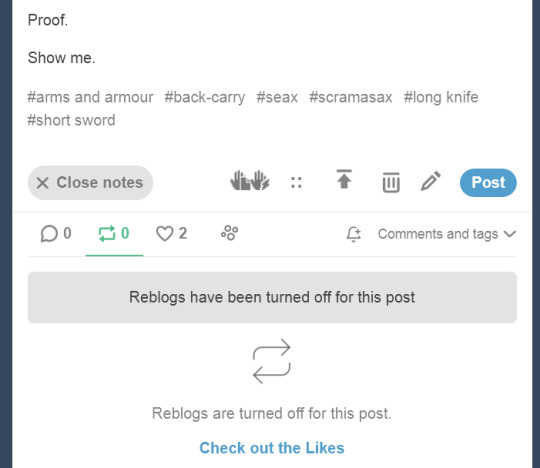
Letting it stand would have seemed like I was trying to avoid comments, corrections or criticism, but despite poking around in Settings there was no way to turn things on. It was only by cut-and-pasting @nimblermortal's entire original as a Quote starting a new post that the problem was resolved.
Anyone else encountered this?
Anyway, on with the lecture response. :->
*****
As regards Back-Carry / Back-Draw of "battle-knives", I'm not convinced.
("Battle-knife" is a term I've never seen in connection with any Viking Age weapon. What's the Old Norse for it? German "Kriegsmesser" (war-knife) refers to something much bigger from 500 years later, also not back-carried or back-drawn - which from here on will be BD / BC.)
To get where he is now, a full professor, Neil Price will have defended his PhD, and should know such a statement as "It seems they may..." will need evidence to support it.
That phrase is easy to write, as is "According to legend..." and "It is said..." However these are IMO default History Channel phrases, with all the authenticity that implies. None of them actually PROVE what they're speculating.
"Experiments conducted by museum staff wearing authentic armour reveal that IT SEEMS medieval knights could use smartphones."
But does it prove medieval knights USED smartphones? See what I mean?
*****
I first asked if anyone had actual proof of BC / BD on Netsword almost 30 years ago, and to date there's been nothing. I've also posted about it quite a lot on Tumblr, so being poked with this particular stick is no surprise. :->
The quotation from "Children of Ash and Elm" is the first time I've heard of a trained archaeologist making a claim for BC / BD, and the odd part is that Prof. Price also states the weapon was intended for "...a short, stabbing blow" - which means wearing it horizontally in front makes far more sense. From that position it can be drawn far faster and with less telegraphed intent than "...on the back - again for a swift, over-the-shoulder draw."
Reaching up for any weapon carried across the back, whether long or short, is a bigger movement - and thus less "swift" - than snatching out the same weapon worn at the hip or across the front at waist level, especially if - as he suggests - that move is masked behind a shield (or for that matter a cloak, a door, or a half-turned torso...)
Try both moves in front of a mirror with a ruler or even a length of dowel, and you'll understand.
With a weapon-hilt visible behind one shoulder or just a cross-belt suggesting something slung out of sight, what's a Norse warrior going to think when his potential opponent reaches up there? At a moment of hot words and high tension, will he wait while an itchy back gets scratched or until an attack happens?
The explosive violence described in sagas suggests not.
If Prof. Price has solid proof for his BC / BD notion in the form of artefacts or art - and it'll need more than a one-off example - I'll be very pleased to finally see some "show me" evidence.
(It won't do anything for longswords of 500 years later, of course, though I bet the uncritical back-carry brigade would leap on it regardless.)
But without that evidence, I'm taking "it seems" with a wary pinch of salt.
*****
There's a weird internet fixation about BC / BD (which are NOT the same thing) and an equally weird need to show that back-draw "works", whether with hooks under the guard and a leather condom at the point...

... or by being open most of the way down one side.

Neither are real-world historical, so let's see how they work in fantasy.
IMO they're not appropriate there either, because the designers are so eager to provide working BC / BD that they ignore the main function of a scabbard, which is to carry the weapon in something which protects people from the weapon's edges, and the weapon from the elements.
Real scabbards for real swords went to some trouble over that. They protected people, including the wearer, with a completely enclosed wooden, leather and / or metal case, and protected the blades by having them fit into their case well enough that inclement weather stayed out.
This fitting could involve metal collars (Japanese habaki), or tight-gripping lanolin-rich fleece linings, or leather flaps, caps and rain-guards mounted on hilt or scabbard-throat. Real scabbards didn't have exposed metal and weren't open-sided rainfall buckets, because the priorities of actual sword users were very different to those of back-carry fans.
Given the number of posts I've seen about the technical side of fantasy world-building - history, geography, even geology and meteorology - I think this difference is worth noting.
*****
The first time I recall seeing back-carry mentioned in a historical-not-fantasy context was in "Growing Up in the Thirteenth Century", © Alfred Duggan 1962. Here's the extract in question:
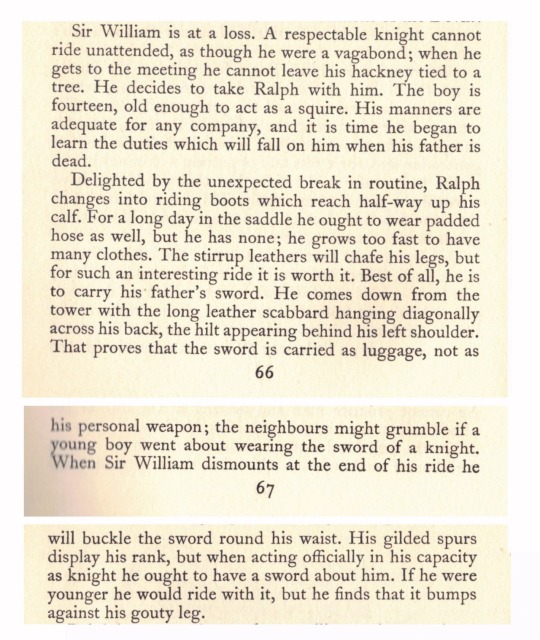
Unfortunately Duggan - though according to his Wikipedia entry "His novels are known for meticulous historical research" - doesn't give any cited source for this; his introduction to the book says:

I know the feeling! :->
I'd still trust him more than some modern historical writers who seem over-willing to add a touch of fantasy speculation / interpretation if it rounds out something inconclusive, makes the history more interesting or chimes with a personal agenda.
"Accurate" is better than "interesting", and "I don't know" is better than making stuff up.
*****
To repeat: I've yet to see any museum-exhibit or manuscript-illumination examples of BC / BD ever done For Historically Real with Western European swords, especially the hand-and-a-half longswords on which modern back-draw fans seem fixated.
A seax, scramasax or just plan sax is shorter, but yet again, this is the first time I've read anything even remotely scholarly about them or their later Viking-age version (saxes were associated more with Saxons than Vikings, guess why?) being BC / BD.
By contrast, there are at least three art instances of saxes worn horizontally, on 10th century crosses at Middleton Church, Yorkshire:

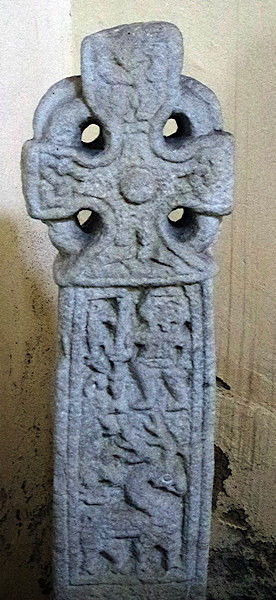

The art is backed up by surviving examples with scabbard-fittings still in place, indicating how they were worn. Here's one example, from the Metropolitan Museum, New York which makes that very obvious.
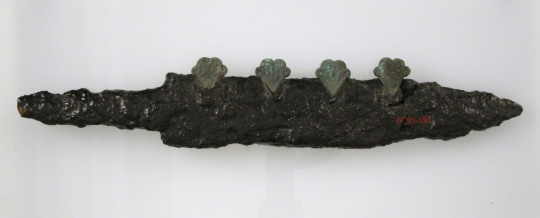
The little decorative masks (originally part of the top of the scabbard, now corroded onto the blade) are clearly meant to be This Side Up, and also show that this scabbard was This Side Out for a right-handed draw, since there's no detail on the back.

There's a similar fancy-front / plain-back / right-hand-use leather sax scabbard at the Jorvik Centre in York.
There's only a single photograph of this bigger one - 54cm (21.5 in) overall - from the Cleveland Museum of Art, with no way to see if the L-shaped scabbard mount is decorated on just one or both sides. However it does indicate the weapon was meant for horizontal wear.
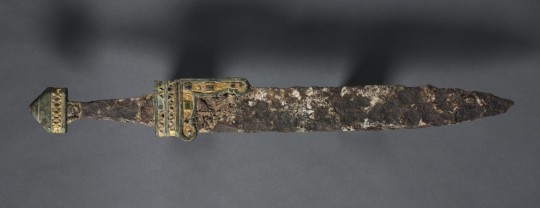
I've also flipped the website photo to show right-hand use, because "It seems..." (hah!) more probable. Here's why I did it:
For most of history being left-handed was unusual, a disapproved-of aberration and the origin of the word sinister.
Left-handers were useless in any formation from Ancient Greece through Ancient Rome to the Saxon and Viking period where the shields of a phalanx, testudo or shield-wall had to overlap for mutual support.
In the Middle Ages, both the specialised armour and the layout of jousting courses were almost 100% right-hand only.
Most surviving swords with asymmetrical hilts, such as swept-hilt rapiers, are made to for right hands not left.
Even nowadays many weapons - including the current British Army rifle (SA-80 / L85/A2) - are set for right-handers only.
*****
The longest saxes are called Langseax (surprise) though this may be a modern-ish term. Here's one from the British Museum, the so-called "Seax of Beagnoth"...

...which is 72 cm (28.5 in) total / 55cm (22 in) blade.
That's about the same as a Roman gladius (another sword never back-worn despite its convenient size) and is a good 25-30cm (10-12 in) shorter than the average "proper" sword of the same period, which means it could be drawn over-shoulder...
However the layout of its runic engraving shows it was almost certainly meant to be worn horizontally As Per Usual.
*****
And now we've come all the way back around to Prof. Price's claim that Vikings did BC / BD with their battle-knives.
Such a claim needs proof.
Please, show me some.
#arms and armour#back-carry#seax#scramasax#long knife#short sword#left-handed weapons#research#evidence
75 notes
·
View notes
Text
Swords Explained (Badly)
Arming sword: it’s the swordest sword to ever sword, nothing to explain, no complexity whatsoever, no sir.
Backsword: the extra-ancient, extra-special secret saber that you need to slay your coach to attain. Alas, for this sin you are cursed to forever wander, alone no matter the density of the crowd, that weirdo at the saber event whose weapon the gear inspectors puzzle over for fifteen minutes before finally shrugging and saying, “guess we’ll allow it.”
Basket-hilted broadsword: a single-handed sword with a unique, all-covering guard design, developed by the Scots to counter the British, who spread their tyranny to all corners of the globe through widespread use of their honorless hand-taps-only style of swordsmanship.
Cutlass: a saber too short to be useful outside its native environment of cramped sailing ships, the cutlass is now primarily used not as a weapon, but as steel plumage in the mating displays of that tropical bird of the sword nerd community, the ren faire pirate.
Dagger: a triangle-bladed spike of steel, the rondel dagger has been proven, by recent archaeological evidence, to be the only weapon that ever killed anybody in a medieval duel.
Dussack: a primitive boffer made from leather and wood. The term “dussack” is also occasionally used to describe a cutlass that happens to be owned by a German.
Gladius: it’s Greek or something.
Katana: A Japanese sword characterized by a curved, single-edged blade with a circular or squared guard and long grip to accommodate two hands.
Katzbalger: the preferred close combat weapon of the Landsknects, the most dangerous polycule of gay furries since the Sacred Band of Thebes.
Kriegsmesser: a curved longsword sometimes mistaken for the world’s biggest steak knife, the kriegsmesser is today wielded by fencers too self-conscious to admit that what they really want is a katana.
Longsword (German): the last of the Third Reich’s technologically impressive but strategically useless wunderwaffen, the German longsword was invented in the waning days of World War II. At first glance a simple two-handed sword, its hidden power can be activated with a 90-degree twist of the handle, which bodily transforms the wielder into an attack helicopter, careening uncontrollably toward its opponent to cleave their skull with its rotor blades.
Longsword (Italian): the apex of edged weapon fighting technology, capable of beat-thrusting its way through the armor of a main battle tank, this sublime weapon was single-handedly invented by the one true Daddy of swordsmanship, Fiore dei Liberi.
Messer: a small single-handed sword, the messer is possessed of a strange psychic property which makes every person you ask give you a different explanation for why it looks like a big knife.
Montante: a sword as lonely as it is horny. Though famous for its ability to take many men at once, this mighty greatsword has lived past its brief glory days. Now, in this degenerate age when large groups of men no longer thrust themselves into tight holes in castle walls, the tragically sexy montante has been largely abandoned by fencers who fear it is too mighty to fight with, even blunt.
Rapier: this extremely fashionable sword was meticulously optimized to defeat other people with the same taste in fashionable swords, exceeded in this niche role only by any other weapon capable of binding with its slender blade, as is related by history’s foremost expert in rapier fencing, George Silver.
Saber (dueling): known from a single extant specimen of an Absolute Fencing-brand electric saber inexplicably dating back to 18th Century France, the dueling saber is among the best evidence we have for the existence of time travel.
Saber (military): a blanket term for dozens of different single-handed curved swords from around the world, military saber as we know it today is a multitude of different martial traditions stitched together into a shambling undead abomination that stalks from club to club, eagerly devouring any fencer too unga bunga to be taken in by the wibbly allure of dueling saber.
Sickle: it’s not a farming implement, not any longer. Not even symbol of communism, no. This weapon has entered its final form as a dagger for people who think they are the main character.
Sidesword: too sexy to be an arming sword, too thicc to be a rapier, this evolutionary link between the two was simply too hot and had to be expunged from history to keep all the other swords from looking bad. It was only rediscovered in the modern day by reconstructive archaeological investigations into the philosophical absolute of “sexy sword.”
Shashka: a primitive saber without any kind of guard to protect the wielder’s precious fingers, the shashka is a weapon wielded exclusively by what is perhaps the most perplexing breed of sword nerd: the Cossack weaboo.
Smallsword: with its feather-light, sewing needle-like blade, the smallsword was invented so that waifish, noodle-armed rich boys would have a more traditionally masculine way to express their desire to kiss each other.
Spadroon: a likely-mythical weapon of extremely dubious historicity. Not only are there no extant examples of this sword, but experts agree there never were any to begin with. Its continued presence in modern HEMA culture is likely due to the deranged ramblings of fencers whose minds have been destroyed by their insatiable fetish for hybrid weaponry.
Swiss saber: a curved longsword with shockingly good hand protection, the ornate Swiss saber also demonstrates why basket-hilted two-handed swords never became popular: they look fucking stupid.
Viking sword: an arming sword that dropped out of school before it could develop even a rudimentary cross guard, the viking sword is the weapon of choice for those whose faith in the Aesir is as unshakable as their love for their only source in reconstructing their religion: the band Heilung.
#hema#historical fencing#fencing#swords#longsword#rapier#saber#viking#sword fighting#shitpost#fuck yeah there's a sequel
90 notes
·
View notes
Text
Lurking on the One Piece wiki again and in the article for Yoru

My brain:
kriegsmesser
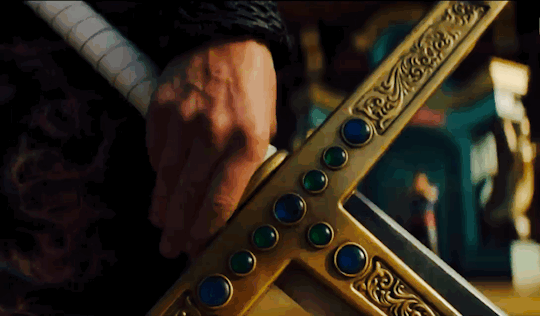
k r i e g s messer
Well
It did messer at least one krieg—

Yes I know "kriegsmesser" translates to "war knife" but I will not apologize for this
64 notes
·
View notes
Text
Weretober 2023 Batch Part 1 - Featuring Newts, Cats, Boars and Local Wildlife
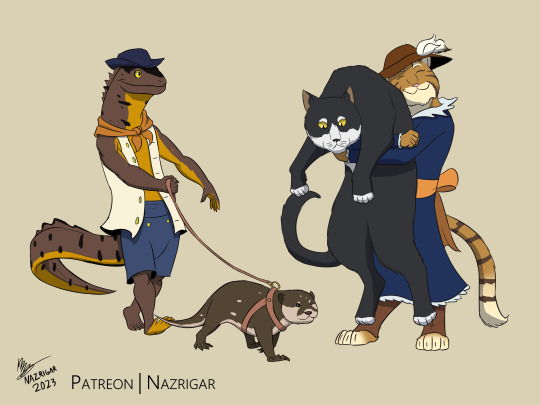

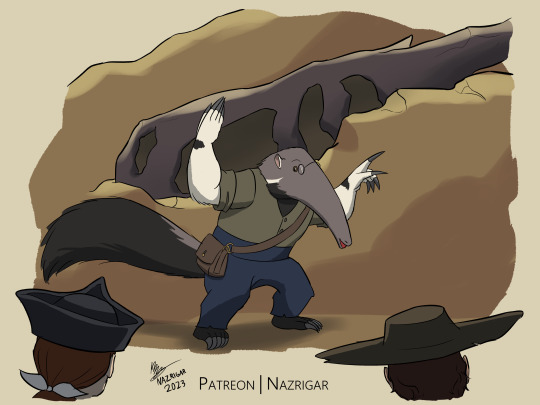

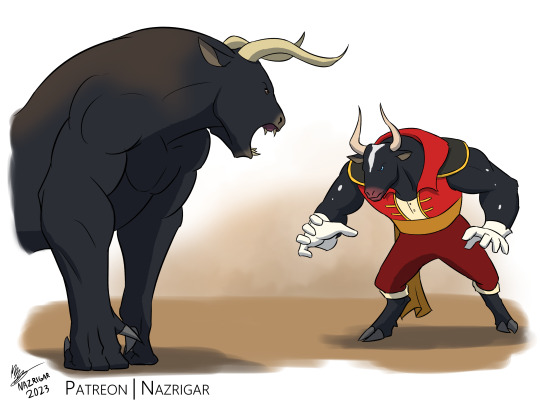
It's Weretober! A big month for my worldbuilding project of Beast Fables, as there's so much worldbuilding to do. Now, to break down the rows:
Pets! A Were-Crested Newt takes his pet otter for a walk, and a were-cat hugs her precious Dire Cat, named tibbles. In Urvara, there's a LOT more varieties of domesticated pets, from otters, to monitor lizards, to even miniature hippos!
Mercenary work is a popular profession in Urvara, especially after a big conflict, where many former military werefolk cannot acclimate back to civilian life. This wereboar shows off his scars, while this werelion, decked in gamebson and hardened leather grieves and armed with both kriegsmesser and musket, demonstrates that, even in the age of gunpowder, melee weapons and armor still has a place in a world where every human can turn into anything from a bear to a scorpion.
A Were-Giant Anteater paleontologist finds the discovery of a lifetime: A Dinosaur chimera, one that looks takes the dragon as its chimeric form.
A werefrog gets the fright of its life, as a Capricorn (a chimeric form of Catfish that gets traits from caprines, such as goats) takes its bait and then some!
A young werebull prepares to duel against a Minotaur, for he is a Minotaur wrestler, like his father and grandfather before him.
#beast fables#weretober#weretober 2023#worldbuilding#great crested newt#otter#domestic cat#lion#wild boar#werebeast#werefolk#anteater#minotaur#bull#character design#creatures#creature design
81 notes
·
View notes
Text




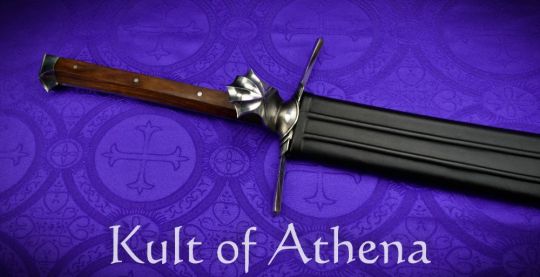
Darksword Armory – The Knochenbrecher Kriegsmesser with Black Scabbard
Weapons of war often evolved from tools used for hunting, farming, or day-to-day survival in a hostile world, and nowhere is that more clear than in the German “Messer” (meaning “knife”) style of swords. Messer swords began as simple, single-edged weapons, merely scaled up versions of the knives from which they descended. Over time, they became distinctive, deadly, and beautiful weapons associated with the Germanic peoples. Darksword Armory’s Knochenbrecher (German for “Bone Breaker”) is based on the Kriegsmesser, meaning “war knife,” the large and imposing weapon of the 15th-century. Large, brutal, and totally battle-ready, the Darksword Armory Knochenbrecher is a powerful cutter – balanced for delivering sweeping, heavy strikes as its historical counterpart would have been.
The Knochenbrecher Kriegsmesser has a tempered blade of 5160 high carbon steel which has been differentially tempered to possess a hardness of 60 HRc at the edge and a hardness of 48-50 HRc at the core. Its guard, nagel and pommel fittings are made from mild steel and the grip halves which are strongly riveted to the blade tang are crafted from hardwood. The hilt has been stoutly constructed with a full tang construction which is further reinforced be peening the tang of the sword over the pommel. Included with the sword is a wood-core scabbard which is bound in black leather and finished with a protective steel chape.
#Kult of Athena#KultOfAthena#New Item Wednesday#Darksword Armory#The Knochenbrecher Kriegsmesser with Black Scabbard#The Knochenbrecher Kriegsmesser#Kriegsmesser#Kriegsmessers#sword#swords#weapon#weapons#blade#blades#European Weapons#European Swords#Medieval Swords#Medieval Weapons#Renaissance Swords#Renaissance Weapons#5160 High Carbon Steel#Battle Ready#new item#new items
7 notes
·
View notes
Text
Shadowhunter families and their place of living.
England
Bridgstock(1903, London)
Baybrook(1903, London)
Branwell(1878, London)
Featherstone(1903, London)
Greenmantle(1903, London)
Hardcastle(1903, London)
Highsmith(1903, 2012, London)
Gladstone(1903, London)
Mayhew(1903, London)
Mayburn(1878, London)
Pangborn(1878, London)
Pouncey(1903, London)
Ravenscar(1878, London)
Townsend(1903, London)
Wentworth(1903, London)
Hayward(1903, York)
Starkweather(1878, York)
Buenos Aires, Argentina
Acosta(2012)
Breakspear(2012)
Gonzales(2012)
Romero(2012)
New York, USA
Graymark(1920)
Safar(2010)
Whitelaw(1984)
Mexico City, Mexico
Delgado(2012)
Mendoza(2012)
Rocio(2012)
Rosales(2012)
Velez(2012)
Brazil
Carvalho(2012, São Paulo)
Pedroso(2012, Rio de Janeiro)
Spain
Casales(2012, Madrid)
Castel(2012, Barcelona)
Villalobos(2012, Madrid)
India
Chaudhury(2007, Mumbai)
Joshi(2012, Mumbai)
China
Ke(2012, Shanghai)
Lieu(2010, Hangzhou)
Wang(2012, Shanghai)
Germany
Grunwald(1721)
Kriegsmesser(2007, Berlin)
Morgenstern(1878, *May be form other german speaking country, also mentioned to be from Sweeden)
Vogelspritz(2010, Hamburg)
Von Mainz(1832, Prusia)
Rome, Italy
Di Aneglo(1903)
Maletesta(2007)
France
Beausejours(2012,*May be from another french speaking country)
Montclaire(1989, Paris)
Pontmercy(2007, Marseilles)
Verlac(2007, Paris)
Portugal
Monteverde(2007, Lisbon)
Rosewain(2007, Cumbria)
Australia
Makepeace(2002, Melbourne)
Sedgewick(2007)
Other
Jahanshah(1903, Persia)
Keo(2012, Cambodia)
Larkspear(2012, Atlanta, Georgia, USA)
Lindquist(2012, Umea, Sweden)
Lovelace(2008, Glascorw, Scotland. 1878, London, England)
Maduabuchi(2012, Lagos, Nigeria)
Kaidou(1878, Tokyo, Japan)
Ashdown(2012, Los Angeles, California, USA)
Theorised
Nightshade(Los Angeles, Califiornia, USA, *Vampire with same last name lives there)
Solcedo(Spanish country, *Taken on by Marisol, who's previous last names were both spanish)
Malhotra(India, *name originates from India)
Tokugawa, Satõ(Japan, *names originates from Japan)
#shadowhunters#the shadowhunter chronicles#tsc#the dark artifices#tda#the last hours#tlh#the mortal instruments#tmi#the wicked powers#twp#tid#the infernal devices#the shadowhunter family tree#shadowhunter families
78 notes
·
View notes